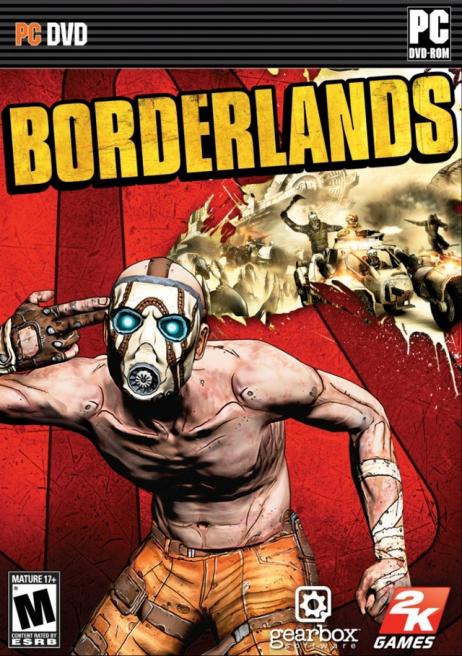Borderlands Review
-
Category: ReviewsHits: 14937

Article Index
Page 1 of 2
GameplayBorderlands is a fairly simple, action-oriented FPS/Diablo clone. The gameplay is as straightforward as that description would indicate: you pick up quests and either follow them or not, killing creatures, bandits, and other (bad guys) all over the map. Quests are a bit of an afterthought; you simply activate them, follow the quest marker, and either kill whatever is at the end or kill whatever is at the end and then press (E). Roughly the level of complexity you would expect from a hack 'n slash.
The game has been referred to as a (sandbox) title, but just like the (RPG) tag, I consider this to be a deceptive categorization. Borderlands is a sandbox in exactly the same way any hack 'n slash is a sandbox. All the maps are open to you once you unlocked them, you can fast-travel back and forth freely once you've unlocked this, and you can do the quests you receive in any order, though again you have to unlock them first. The quests and maps are always the same, and thus play out the same way. If this is the definition of sandbox, then the entire hack 'n slash genre fits there anyway, making it a meaningless point of reference.
Borderlands fuses the genres of hack 'n slash and FPS more efficiently than has been done before. The shooter gameplay feels natural and solid, though no amount of twitch skills are going to overcome using bad, underpowered weaponry, or taking on enemies that are simply too difficult for you. A nice touch in its fusion is the fact that critical hits are determined by where you hit the opponent (different enemies having different weak spots), rather than a random dice roll.
But like so many fusions before it, Borderlands does not manage to excel at either of the genres it represents. The FPS gameplay certainly works, but it's ultimately limited: the enemy AI is lacking, there's not exactly a rich variation in types of guns or types of enemies, and a lack of basic environmental functionality when it comes to cover or destructible environments makes for semi-uneventful if not overly simple shooting action. The boss-fights are a good example of this game's limits as an FPS, as in singleplayer many of them can be won y combining bunny-hopping and circle-strafing and just pelting the boss.
Similarly, the character and loot system are very shallow compared to the current standard of hack 'n slashes. There are four classes (Hunter (rogue), Siren (mage), Beserker (barbarian), Soldier (paladin)), each with a basic skill tree that includes a stack of passive skills and only one activated talent per character. The passive skills are fairly unique and combine for different playstyles (for example, you can turn the beserker into an offensive powerhouse with explosive weapons, hand-to-hand fighter and/or prototypical tank), but the lack of activated talents is a shame, especially when not all activated talents are equal (the Hunter's is kind of weak compared to say the Berserker's).
There's a fairly rich set of basic weapons (pistols, snipers, SMGs, combat rifles, shotguns, rocket launchers and alien rifles), with a variable set of boosts (from elemental damage to less recoil to faster reload time), but the aforementioned over-simplicity seeps in here, too. The procedural generation of these weapons allowed Gearbox to brag about a (bazillion guns) available in the game, but this claim is as meaningless here as it is for any game featuring randomized loot.
The variation mostly comes down to small tweaks in stats, and most of the guns you find will simply be inferior to what you have. One bonus point the game gets here is when it throws kinks into your expectations, such as rapid-fire rocket launchers or the different kinds of scopes available, but don't expect too much from the game's purported endless variation. Such simple standards as gunsmithing or custom weapon modifications would have improved the limited loot range quite a bit.
The game uses a color-coded system for rarity, and you can find weapons from the basic (white) to the most rare (orange). The epic (purple) and legendary (orange or yellow) weapons in particular often have unique (if short) descriptions and the most interesting effects, such as causing multiple types of elemental damage.
A lack of customizability of characters seems to indicate that Gearbox completely missed one of the key draws of action RPGs: admiring your character decked out in dozens of hours worth of confiscated loot. It's an infantile pleasure, but still a pleasure though admittedly a less important draw in a first-person game. Instead, this game barely offers any customization (other than tweaking your character's color scheme), with armor having been replaced by invisible shields. A hugemiss when you consider Borderlands' setting would allow for some fairly badass Mad Max getups.
After the game has been completed once and you've sufficiently recovered from the letdown of the terrible ending fight and lack of end-game loot (seriously, no end-game loot other than some cash? In a hack 'n slash?), you can go for playthrough #2, which is essentially just a higher difficulty with requisite better loot, though the challenge level does make it an interesting experience. More than these two levels of difficulty aren't available, quests can't be replayed unless your host hasn't done them, and the level caps off at 50, effectively strangling long-term draw for sticking to a single character.


